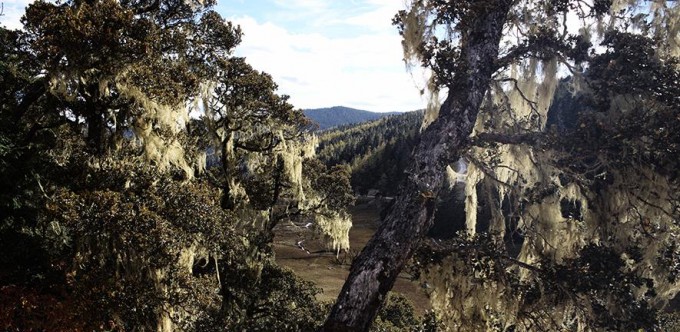
It is a forest in southern Yunnan Province of China. Researchers at the University of Cambridge in the UK revealed the results of a study that the area changed from tropical shrubs to tropical savannas, which are good for bats due to climate change, triggering a new coronavirus outbreak (Corona 19). Courtesy of Cambridge University.
A new coronavirus infection (Corona 19), which killed more than 2.3 million people around the world in just one year, is actually a result of climate change, a study found. According to the analysis, the vegetation in southern Asia, including southern Yunnan Province of China, for 100 years has changed into an environment where the virus-bearing bats live due to climate change, and the increase in wildlife capture and trade has led to the emergence of deadly viruses that infect humans.
After the Corona 19 incident, there have been several claims in the scientific community that a deadly infectious disease has emerged as contact between humans and wild animals has increased. However, it is the first time that such extensive analysis as in this study has provided evidence that the ultimate cause is climate change. Meanwhile, a World Health Organization (WHO) investigation team who visited Wuhan, Hubei Province, China to find the origin of Corona 19, revealed on the 6th that it found an “important clue” in the seafood market in Wuhan, where the first group infection occurred, taking one step further to determine the path of infection It is attracting attention whether it can be hypothesized.
● Over the past 100 years, 40 bat species have been introduced… more than 100 coronavirus species
Researchers at Cambridge University in the UK and at the University of Hawaii in the United States said that due to climate change resulting from the increase in greenhouse gas emissions over the past 100 years, southern China, Laos, and Myanmar have changed into vegetation that is good for bats, and it is highly likely that this is the source of Corona 19. It was released on the 5th in’Comprehensive Environmental Science’, an international academic journal in the field.
The researchers tracked the changes in vegetation in the last 100 years in these areas. Changes in vegetation were mapped based on data on temperature, precipitation, cloud volume, insolation, and carbon dioxide concentration. Southern China, Myanmar, and Laos were tropical shrub forest areas only a century ago, but now they have been transformed into tropical savannas and deciduous forests that bats love as their habitat. Forests with tropical climates, which are taller than shrubs, rather than tropical shrubs with medium-sized or smaller shrubs, are an environment that enriches the feeding of bats.
The researchers analyzed the worldwide distribution of bat species in the early 1900s and the distribution of the current bat species. Over the past 100 years, 40 species of bats have been reported to have flowed into the regions of Laos and Myanmar, adjacent to southern China. It is estimated that there are more than 100 coronavirus types possessed by these bats. Scientists estimate that a population of bats distributed around the world may have about 3,000 different types of coronavirus. In terms of a single bat, it has an average of 2.7 coronavirus species.

A map showing the degree of diversity of bat species by region around the world completed by the research team. The darker the red, the richer the diversity of bat species. Bat species in southern Yunnan, China and neighboring regions such as Myanmar and Laos have increased by 40 over the past 100 years. Courtesy of Cambridge University.
Bats have a variety of viruses in their bodies, but they do not have an inflammatory reaction and are therefore designated as key hosts. Infectious disease scientists see a high probability of the emergence of a virus that can infect humans if the number of bat species suddenly increases in a specific area. “As the habitat changed due to climate change, some bats migrated with the virus,” said Robert Bayer, a researcher at Cambridge University. “Not only has the area where the virus exists has changed, but the likelihood of viral mutations that infect humans has increased.”
Researcher Bayer also said, “The region in southern China, where the number of bat species appears to have increased recently, coincides with the main habitat of pangolin, which has been designated as an intermediate host for Corona 19.” “It is a coronavirus-like infectious disease like Corona 19 and a severe acute respiratory syndrome outbreak in 2002. (SARS, SARS) also started in southern China.”
● Blocking the threat of future infectious diseases only when actively responding to climate change
“Understanding how the global distribution of bat species has changed as a result of climate change can be an important clue to reconstructing the origin of the COVID-19 outbreak,” said the researchers. “Preventing the spread of potential viral infectious diseases between species in the future. In order to do so, a wide range of efforts, such as protecting natural habitats and banning wildlife trade, is needed.”
The research team argued that as it was confirmed that climate change has a substantial effect on the outbreak of viral infectious diseases, countries should actively respond to climate change to resolve the essential problem.
“Corona 19 is causing tremendous social and economic damage to the world,” said Andrea Manicker, professor of zoology at Cambridge University. “Efforts to mitigate climate change will be an opportunity to reduce the threat of other infectious diseases in the future.”
